It’s time I mentioned the Kestrel e400i that will celebrate its first year of trouble free operation here on Scoraig in January 2012. It’s installed at the Dome on a tower that was originally used to test the prototype Proven 6kW turbine (now the Kingspan Wind 6kW) in the late 1990s when Topher made the blades for that turbine. That old turbine finally died of magnet adhesion failure. I had to weld on an extension pipe to the tower for the Kestrel’s blade clearance.
Here are some photos:
I have yet to hear a bad word spoken about this turbine. There were no issues with it during installation and it has never gone wrong. (This is rather a spooky experience, given my previous knowledge of the technology.) This turbine was designed by a Scotsman, Jim Carpy, and is built in South Africa. Eveready SA acquired Kestrel wind Turbines in 2006. It does not as yet qualify for Feed in Tariffs via the MCS process. I am told that the same turbine is now available as the upgraded Kestrel e400nb with a 3.5kW rating. “The e400nb is on independent testing with TUVNEL in East Kilbride since July 2011 and has also operated faultlessly. The test machine is grid connected with a Power One Aurora 3600 inverter.”
I fitted the system with a DC energy meter by Eltime Controls and we log the energy production every month. Over the last 9 months it has averaged 400 kWh per month. In October it produced 650 kWh (22 kWh per day). During some of these months the turbine as been out of action for periods due to shortcomings in the load control system.
This is a legacy 110 volt battery system with 5 kW sine wave inverter and some very old sealed batteries from a military site. (Note the 9 PV modules in one photo.) For reasons of economy and to avoid the noise associated with PWM load control systems, battery charge control is achieved using two Morningstar Relay Drivers. The first channel in each RD is used as an input. The six outputs drive five heaters and a wind turbine trip signal that shuts the turbine down via its own ‘interface unit‘.
This works ‘adequately’ and provides a lot of heat, but there were teething troubles during which the inverter cut out, causing the turbine to trip.
The Kestrel runs very fast, but is smooth and quiet. The sound it makes is businesslike, clearly audible but not intrusive.

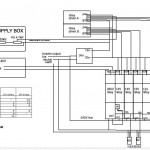
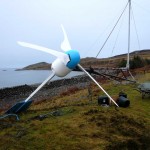
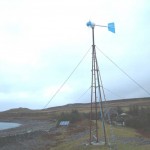
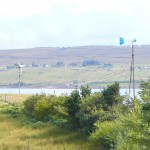
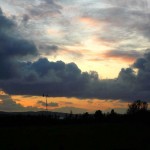
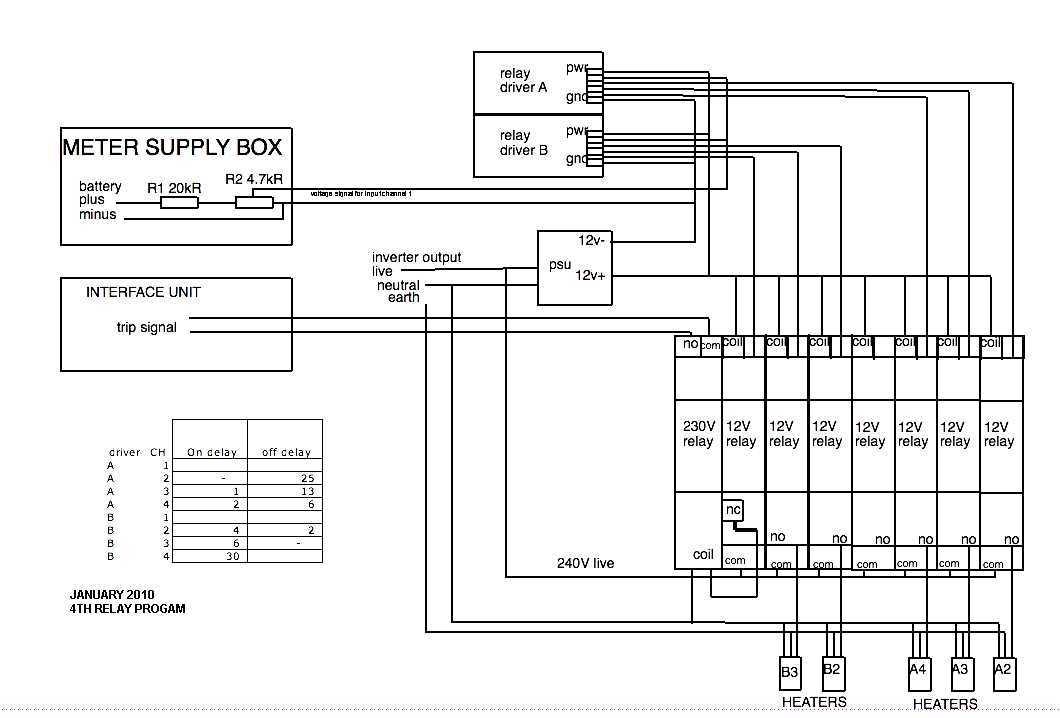

Hi Hugh,
Mick Womersley here in Maine USA. I’m looking for information on the Kestrel e300i.
My students and I took one of these things down for a community partner (a non-profit conservation group) after it quit on them, and now have it dismantled in our shop, trying to see if it can be repaired. I’m contacting people I can find in the US or UK that have handled the Kestrel, looking for information. The company in South Africa will not return my emails, and after talking to several former dealers, I’ve decided they likely will not help at all.
Have you every removed the generator end cover plates on one? That’s my immediate problem. If I can figure out how to do that, I can determine if it can be repaired or not.
I removed all the bolts, but both end plates are stuck on, and neither side can be pried open more than an eighth. I can put it in a mechanical puller, but need to know that I won’t damage anything inside if I do that.
You may know how to do this, or you may know someone else who does. That would be very helpful.
Thanks for any information you may have.
Mick
Mick Womersley,
Professor of Human Ecology
Lead Faculty, Sustainable Energy Management Program
Unity College
90 Quaker Hill Road,
Unity, ME 04988
Unity House,
207 509 7259
I bought a 400 3.5 Kestrel (e400nb) several years ago and the windmill grabs as it tries to turn…How can I get the electrical diagram or schematic for the resistors inside of the turbine? Its not the bearings but the diodes.
Thanks,
Mitchell Shupp
hi, i have a house :4 x bedrooms, 1 x dining room, 2 x lounges, 2 x kitchens, 1 x remote gate and 1 x garage and 2 x bathrooms. what wind turbine do i need i thought i could go for the e400bn as im running two gas geysers, what would something like this cost me and installation as well,
thanks,
petrus
hi
It’s the number of people in the house that matters as the many rooms will not use power unless a person turns a switch. maybe check your utility bill and see how many kWh units of energy you use already and this is the info you will need. If you are located in the UK then I am not sure that kestrel is for you as there is no support for the product outside of south africa at present nor do they plan to support it so far as I am aware. Great while it works but bad news when you need help.
Hugh
Our 4 Channel DC Energy Meter comes with options of Shunt, Hall Effect Sensor, Split Core Hall Effect Sensor. The device can be connected through RS485 or we can provide a complete Remote Energy Monitoring Solution.
What is the current status in late 2013? This is with regards to rotor balance and fiberglass blade life? Did you have any tower related vibrations?
Pass a statute law protecting all roofs of buildings from overshadowing from neighbors and an appropriate appeals process to separate the exceptions for
the general rule. Go ahead & continue on as I further discuss Solar Power.
In light of the costs associated with changing from regular electric to sources that are friendlier to the environment, the United States government can initiate a program to interest citizens to make
changes to their homes that would increase the use of solar energy.
People of today attempted to minimize their expenses because of economical crisis.
Though I cannot speak for Hugh, from everything I know about these machines, I would think that a 400 nb would work well in your locale. The only concern I might have would be the proximity to the sea at your site and the possible need for extra corrosion protection. Not that they are particularly vulnerable to salt spray, but they aren’t galvanized either. Perhaps having it powder coated (where possible) would work as well as hot-dip galvanizing? For sites somewhat removed from direct salt spray the factory finish is very adequate. One very nice thing about Kestrel machines installed in a marine environment is the lack of aluminum parts. 🙂
I stay in Orkney where there are a large number of turbines operating successfully and many more going through the planning process. SSE called a meeting with all interested parties and informed us that they would not be issuing any more grid connections until 2020(when they would be upgrading the marine cable crossing the Pentland Firth). They said that the network in Orkney could not cope with any more small scale developments(< 50kW). They did say that they could offer grid connections to turbines under 3.7kW – I wonder if the Kestrel e400nb would be on option for Orkney assuming that it could handle the conditions found here.
Hi All,
And what about the price of this Kestrel e400nb? Do you know how much does it cost installation excluded?
Best regards
PM
what is the approximate price of a Kestrel 400ei Thanks. Jim Kean
Hi Jim,
Unfortunately I do not think that Kestrel have an agent in the UK at present. Maybe best to ask them yourself.
Hugh
I got this message from James Carpy of Kestrel:
“Just to say that the Kestrel e400nb (braked version of yours) was finally
awarded MCS certification. Another milestone in the journey. It performed
perfectly for the six month test and has now run on for >1 year. We still
call it “Spooky” after your own comment on your website about its
reliability. NEL are still using it for their own investigations on data
bin size but all is well. Spooky has survived while so many others have
broken up on the site.
Thanks and regards,
James”
Hi Hugh
I have same issue with my wind turbine giving only 40V to charge a 48 battery system.
this system is built to charge 2800 Amp.hr along with 1000 watt solar panels connected using your suggested configuration with MPPT charger controller.
I am suspecting the Tri star PWM controller that suppose to control the wind is damaged but I am not sure how I can verify this.Is this a battery issue. As soon the batteries read minimum 46V then the inverter charger will kick in. The thing is I can see the current increasing at high wind upto 14Amps and the volatge stay around 40V only! is that mean I am still charging the 48V battery or am I draining these batteries?
hi
I would not have been the one who suggested that you use a tristar MPPT controller for a wind turbine. Although it may be possible. Make sure that you have the correct settings if you do that!
The only thing that a tristar diversion load controller could be doing to bring the battery voltage down to 40 volts is to dump energy into heaters and you will see if they are getting hot.
I suspect that you are using much more energy than the system can produce. Stop using energy if the battery voltage drops below 48 volts.
Check the current from the wind and solar sources. If they are low or these is none then ask is there enough wind or sun? If so then find out what is stopping them working. I have done some troubleshooting articles in Homepower magazine that might help you to find out what has gone wrong in your case.
all the best, Hugh
Thanks Hugh
Just to clarify, I am using PWM Tristar with diversion controller for the wind and a different MPPT controller for the solar and all connected to inverter charger according to your suggested schematic.
The solar work fine, the wind turbine is making current when there is more wind but when I measure the maximum voltage I read 40V AC while I can see the that the batteries are 48DC . The rectifier will get worm but the diversion load is still cold.
When I disconnect the wind turbine from the batteries, I can see the voltage increase to about 80V AC when I rotate it be hand.
Is that normal or do I need to read at least 48AC phase to phase in the wind turbine when I connect it to the batteries.
Thanks again for your hep and the valuable information
hi Dia,
Glad to hear more as I did not understand the previous. In order to produce 48 volts DC, the rectifier has to be fed with 35 volts AC. If the battery voltage is 55 Vdc then the wind turbine voltage will be around 40 volts when charging this battery. DC output of the rectifier comes from the peak of the AC input which is about 1.4 times higher than the ‘rms’ or normally measured AC voltage. The rms is like a kind of average voltage that is .71 times the peak voltage. There will also be a small loss of voltage in the rectifier.
So it’s normal for the wind voltage measured on the AC side to be lower than the battery voltage. If there is current and the rectifier is warm (maybe fit an ammeter for the wind turbine input?) then I don’t really understand the problem, and there may not actually be a problem. If the battery voltage falls then you are using more power than the system can provide and must upgrade the system or use less energy.
I hope this helps – Hugh
Yes, Hugh that is really helpful. I really appreciate your input.
I think then it is normal to see these numbers.
What I am not sure about now why the turbine is too slow when I connect it to the batteries even at high wind speed. as soon I disconnect it from the batteries the turbine rotate quickly again. Is that normal too or I need to modify something. I am worried the rectifier or the controller is damaged.
Thanks
hi
The wind turbine is like a wild animal with its foot on the throttle. if you put it into neutral the engine will race. Get it into gear by connecting it to a load and the engine will work and it will slow down. There is no speed governor because the energy is free, so if you don’t use the energy it gets used to make the turbine over-speed.
Can someone provide me with real numbers from installations (wind speed vs turbine output) of the Kestrel e300 and e400nb compared to the ones hugh built for 10 ft and 12ft 48V design . The area I live in is averaged 6m/s wind speed in the winter and about 4m/s in the summer. This information will be a good indication if the cost of the new turbine is worth the investment.
Thanks
I am very interested in wind power, but I have read so much about it I am dizzy, there are so many claims and counter claims. What I would like to know is, is it feasible to install a W/T that actually delivers (obviously depending on wind) what is claimed.
I am pleased to read a positive review about the Kestral, it seems there is at least one happy customer. What I would really like is a W/T that will produce the most efficient energy either ‘back to grid’ or ‘stored’, I understand they both have some downsides.
And most importantly the cost involved for the Kestral.
Regards
Mario
Daily electricity demand varies around the world. In the UK and Europe it’s somewhere around 10-20 kWh per day on average (you can google that later). In north america it’s a bit higher and in the developing world much lower.
I don’t sell Kestrel turbines but they do produce good energy output on a suitable site. We’ve been keeping records on this site for over a year and here are the daily kWh averages for a number of monthly readings. Readings are not exactly monthly but the number of the month is included in the left hand column for a rough guide to the time of year:
MONTH KWH PER DAY
1 –
2 16.0
3 15.7
4 14.5
4 12.0
5 10.6
5 5.0
6 19.7
7 5.2
8 3.2
9 9.0
10 13.4
11 21.0
12 16.6
1 24.3
2 22.6
3 19.8
4 16.0
5 5.2
6 6.4
7 4.9
how much power consumption does an ordinary urban home needs, and what kind of system do you recommend from your available products
Kestral wind generator fitted on a friends farm in France
Its a 24v system charging 4 135ah batteries through a charge controller
the output from the generator is only 22.4v so each battery only receives 11.2v
this system can never work?
as soon as the 2500w Inverter is called on it senses a low voltage in the batteries and trips off
yes it was fitted by professionals
and so I say be careful out there.
Hi Paul,
I obviously don’t know the details of your friend’s system but I will say this. The battery voltage is what controls the wind turbine voltage and not the other way around. If the battery is low then it is quite normal/necessary for the wind turbine to work at that low 22.4 volt level whilst trying to recharge the battery. As the battery is recharged, then you will find that its voltage will rise and the wind turbine will be ‘producing 24 volts’ or 28 volts or whatever the battery voltage is. The wind turbine voltage is very flexible and adapts to suit the battery.
The next question is obviously ‘why is the battery flat?’ The wind turbine will recharge it given sufficient wind. So my guess is that there is not enough wind on the site for the turbine to recharge the battery. Or alternatively there is a defect in the battery, or the battery is being drained by some other item such as a DC load.
It may equally be possible that the turbine itself is defective but the fact that it is producing a 22.4 volt output is not a defect as such in this situation. The wind turbine voltage is constrained to be the same as the battery. It’s the nature of the beast.
I hope this helps. I would focus on observing the current (amps) that the turbine is producing and also checking if the wind (metres/second) is adequate. Then make a judgement based on having adequate wind and inadequate output current.
best wishes,
Hugh
My farm is located south of VanWyksdorp close to mountains. In the afternoons the windspeed increases tremendously. Many turbines on adjacent farms have been lost due to high winds. What windspeed can the Kestrel withstand?
Hi Hugh,
I’m sure you covered this in your response, but the Kestrel e400i has been (very) successfully employed as an exhaust energy reclamation unit in at least one mine vent in South Africa. I imagine that it gets pretty filthy, pretty quickly, since it’s a coal mine. The trick is to place the turbine back a bit from the vent to prevent creating back pressure, which would not be good! I have been an advocate (and technical support contact) for Kestrel machines in the US since some time in 2004, and am very happy with their progress in design and build quality.
I agree that the Kestrel is a very efficient turbine with nice attention to detail that makes for a trouble-free experience.
However I am still disturbed by the idea that people think that putting a wind turbine on the outlet of a ventilation system can be the best way to save on the energy used by the system. A system that throws air out at such high velocity is not well designed for energy efficiency. I am convinced that a suitably designed conical diffuser that slows the velocity (and kinetic energy) of the exhaust would reduce the back pressure on the fan and save energy at much lower cost. But people always do prefer solutions with lots of moving parts. So who am I to interfere. 🙂
I was looking at options to create wind energy from the exhaust fans that exist. Do not find many such application on the Internet?
The speed considerations are higher than standard for mini/micro wind turbines -which should be good for energy haevers but the stability could be an issue. Any suggestions!
Regards,
Vinit@india
hi Vinit,
It’s not a good idea to put a wind turbine on an outlet of an exhaust fan since this will block the flow and make the fan work harder.
Further comments. It has been pointed out to me that you can produce useful energy this way without putting significant extra load on the fans. I am probably wrong then. I often am. I apologise for that.
However my instinct is that this is not the most effective way to save energy. A simpler solution would be a diffuser (conical pipe that grows gradually larger) at the outlet. Such diffusers are used for example in low-head hydro installations where water might exit at speed. The reduction in flow velocity means less energy is lost and there is consequently less back-pressure on the fans that drive the system. Saving energy is usually a better solution than generating it. Worth looking into.
Hi Vinit,
We have successfully tested a few Kestrel turbines on the AHU exhaust in Chennai, Gurgaon and few other cities on the rooftops of the building. There is a bit of science involved in terms of the distance of the hub from the outlet and the wind speed striking the blade tip. The design of the duct/evase is the key. Indeed, leveraging this high speed wind ( 10+m/s) from the AHU outlet is now an integral part of the green building plan for several emerging corporate buildings in India. We , E-hands Energy ( India) Pvt Ltd leads the pack on this expertise in India.
As pointed out by Matt Tritt, Kestrel has been deployed in quite a few places on the air outlet.
We partner with Eveready South Africa to offer the Kestrel range of turbines in India. There are over 30 Kestrel installations in India; the oldest one deployed in Binsar, Almora, Uttarakhand at 9500 feet, doind extremely well; trouble free since March 2010 !!
Happy to share our experience on micro wind turbines in India.
Raghu
Hi Raghuraman
How much power are you making from the AHU oulet? how far the turbine is from the outlet? what brand Kestrel you used?
Thanks
The wind turbine in this article is not home-built. It comes as a complete product from South Africa. If you are interested in building turbines then you have come to the right place. There is a great deal of information on this blog and my old site http:www.scoraig.com
The best and most recent guidance is most clearly explained in my books. So I would recommend that beginners start there, and then read more widely in the forums around the world that other home-builders chat on. You can get parts from suppliers listed in my plans and also by reading these two sites and various forums.
Enjoyed reading this article. It makes me wan to start building wind turbines. Does this turbine come as a kit or are there more complete plans and where would a person locate parts. We carry some of the basic stuff on our website but we dont have everything. Were is a good place to start learning for a beginner?
Thanks